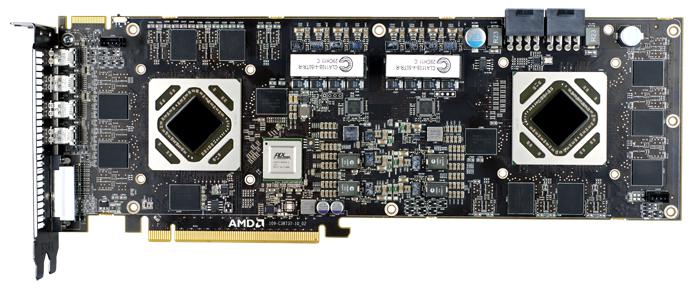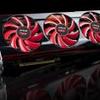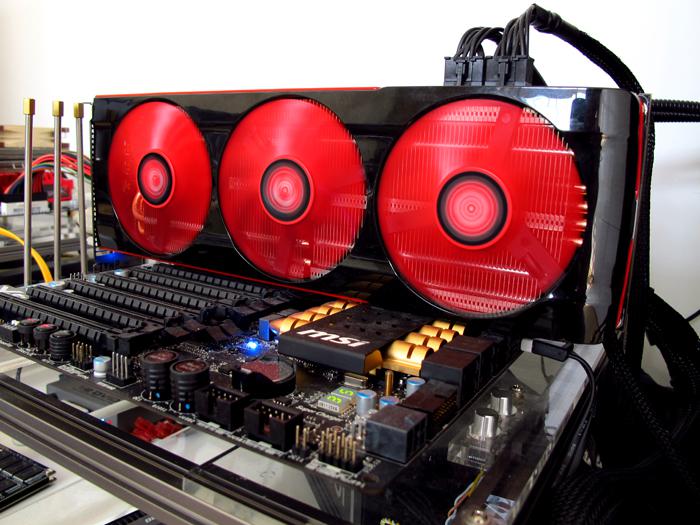Specifications and Sea Islands
Specs & Southern Islands
Southern Islands
We always start off with a little introduction towards the entire product stack and their respective code/family names. You've heard and learned about several codenames and that can be a little confusing so we start of with that first. It's simple really, in the market we have entry level, mainstream and high-end products. When you notice "Verde" that's entry level. Pitcairn will be the codename the mainstream products will hide under, and finally Tahiti is the codename for AMD's most high-end products in the 7000 range of products.
- Entry level = Verde = Radeon HD 7700 series
- Mainstream level = Pitcairn = Radeon HD 7800 series
- High-end level = Tahiti = Radeon HD 7900 series
- Enthusiast level = Malta = Tahiti XT based 7990
AMD Sea Islands (Desktop)
- Oland (Low Cost-Chip GCN-Basis, 384 Shader-units and TMUs - 16 ROPs - 128 Bit DDR Interface)
- Bonaire (Mainstream-Chip - GCN-Basis comparable to Cape-Verde Chips - Radeon HD 7700 Series)
- Hainan (Possible Performance-Chip - GCN-Basis - comparable Radeon HD 7800 Series)
- Curacao (Possible High End-Chip - GCN-Basis - R1000/Tahiti-Chips comparable Radeon HD 7900 Series)
- Aruba (Possible Dual-Chipsolution)
Technology
For the series 7000 in general the GPU architecture was overhauled, Back in 2011 AMD moved towards a 28nm process technology, the cards are all PCIe gen 3 compatible and there have been significant changes on power consumption. With the launch of the Radeon HD 7000 series, Eyefinity was also updated towards version 2.0 with full support for DDM audio (you hear audio on the actual monitor it's played of), a new 5x1 landscape mode is introduced, and you may now create custom multi-monitor resolutions.
Radeon HD 7990
Let me throw some specs at you, 8.6 Billion transistors, 4096 Stream processors, 8.2 TFlops and 6 GB of memory. Impressive eh? AMD bakes GPU's on the 28nm node, in very simple wording that means they can put more transistors on a smaller silicon die area. The Tahiti core has 4.3 Billion transistors (the PDF we received (below) is showing 2.8 billion for some reason -- which in fact is pitcairn R7850/7870). So make no mistake -- the same silicon Tahiti XT is being used though for the GHz edition, the Tahiti XT/XT2 GPUS are packed with 2048 shader processors harbored in Compute Units segments (32 of them) per GPU.
| Card | Radeon HD 7990 | Radeon HD 7970 GHz | Radeon HD 7950 |
| Process | 28nm | 28nm | 28nm |
| Transistors | 8.6 Billion | 4.3 Billion | 4.3 Billion |
| Engine Clock | 1 GHz | 1.05 GHz | 925 MHz |
| Primitive Rate | 2 prim / clk | 2 prim / clk | 2 prim / clk |
| Stream Processors | 4,096 | 2,048 | 1,792 |
| Compute Performance | 8.2 TFLOPS | 4.3 TFLOPS | 3.3 TFLOPS |
| Texture Units | 256 | 128 | 112 |
| Texture Fillrate | 256 GT/s | 118.4 GT/s | 89.6 GT/s |
| ROPs | 64 | 32 | 32 |
| Pixel Fillrate | 64 GP/s | 29.6 GP/s | 25.6 GP/s |
| Z/Stencil | 256 | 128 | 128 |
| Memory Bit-Interface | 2 x 384-bit | 384-bit | 384-bit |
| Memory Type | 6GB GDDR5 | 3GB GDDR5 | 3GB GDDR5 |
| Data Rate | 6.0 Gbps | 6.0 Gbps | 5.0 Gbps |
| Memory Bandwidth | 576.0 GB/s | 288.0 GB/s | 240.0 GB/s |

That 384-bit memory is clocked at impressive speeds, 6.0 Gbps that's bandwidth up-to 288 GB/sec per GPU.
Memory volume wise the R7990 cards will pack a massive 3 Gigabyte of DDR5 memory per GPU, so that's 6GB in total. This is not done for bragging rights, but AMD simply takes Eyefinity and multiple monitor usage more serious, it is there where the extra memory makes sense. The memory bus of course is still 384-bit (x2) as well. Packing so many transistors on a product is staggering, but if you can't apply a fast enough clock frequency it would become a problem. Well, that's not an issue for AMD either, the Radeon HD 7990 is clocked at a very fast 950 MHz with a boost capability of 1000 MHz.
The boost feature simply is dynamic clocking, the card has a set power target. E.g. in very simple wording the card does something like this: say the card is allowed to use 225 Watt per GPU, so if at 950 MHz the card uses 175W it will then clock to 1000 MHz as there is room left in the power envelope bracket. However if it has reached that 225 Watt wall it'll do vice versa. The suggested TDP for the Radeon HD 7990 is 375 Watt by the way.


